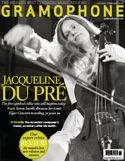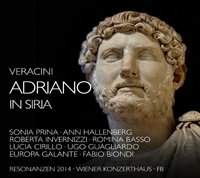Texte paru dans: / Appeared in: |
|
|
Outil de traduction (Très approximatif) |
|
|
Reviewer:
David
Vickers Madcap Florentine violinist Francesco Maria Veracini (1690-1768) composed Adriano in Siria (1735) for London’s Opera of the Nobility. The cast included Senesino (title-role), Cuzzoni (Emirena), Bertolli (Sabina) and Montagnana (Osroa) and the role of Farnaspe was sung by the recent recruit Farinelli. Metastasio’s libretto was adapted extensively by Angelo Maria Corri but the synopsis provided by Fra Bernardo only gets the reader so far. No libretto is included, so listeners with academic internet capabilities might wish to download the original 1735 wordbook. Holger Schmitt-Hallenberg’s booklet essay, albeit fascinating, contains a lot of factual errors and casual misrepresentations.
Lord Hervey moaned that Adriano was ‘the longest and dullest Opera…ever inflicted on the ignorance of an English audience’ but my own research has led me to suspect Veracini’s music deserves a chance to be heard. An obstacle to this was the lack of recitatives in the surviving manuscript sources but Fabio Biondi has constructed them editorially from a later setting by Ferrandini (Munich, 1738). This live Vienna Konzerthaus recording crackles along with theatrical conviction; Europa Galante obviously relish strongly contrasted sequences of arias that are rich in virtuoso detail and pack plenty of theatrical punch.
The vengeance-obsessed Osroa’s fizzy ‘Sprezza il furor del vento’ is sung powerfully by Ugo Guagliardo, whereas Roberta Invernizzi beguilingly wrings every drop of pathos out of Emira’s lament ‘Prigioniera abbandonata’, and her showstopper ‘Un lampo di speranza’ uses a concertante violin and hints at the theme from Vivaldi’s Spring. Sabina’s realisation that Adriano desires another woman (‘Numi, se giuste siete’) is sung by Romina Basso with subtle nuances that mingle disconsolate heartbreak and hints of fury. Sonia Prina’s fruity vibrato is riper than ideal for the lovely melodic vocal lines tailor-made for Senesino in Adriano’s softly indecisive ‘La ragion gli affetti ascolta’. The scenes concluding Act 2 show Veracini’s dramatic capabilities at their best: concertante strings play dissonanceladen harmonies exquisitely in Emirena’s melancholic ‘Quell’amplesso e quell perdono’, horns and drums are unleashed to thrilling effect in Osroa’s defiant ‘Se mai piagato a morte’, and ‘Amor dover rispetto’ is a colossal tour de force featuring trumpets, occasional concertino violins and extraordinarily difficult coloratura, sung by Hallenberg with aplomb. Farnaspe’s final aria ‘Son sventurato’ is a ravishing example of music designed to display Farinelli’s softer lyrical side; whether flashy or tender, Hallenberg’s magnificent singing takes no prisoners.
Adriano
should not be exaggerated up to a level with Handel’s two masterpieces dating
from the same year (Ariodante and Alcina), but its vividly characterised arias
are appreciable on their own terms and hang together much better has usually
been assumed. Snap up Fra Bernardo’s limited edition issue while you can.
|
|
|
|
|
|
Cliquez l'un ou l'autre
bouton pour découvrir bien d'autres critiques de CD |
|




